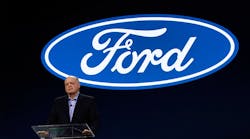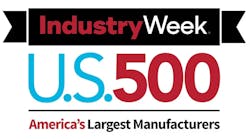Ford Vows ‘Fitness’ Boost as Revenue Boom Fails to Propel Profit
Ford Motor Co. reemphasized the need to trim costs under its new CEO as strong revenue didn’t fuel enough profit to help its struggling shares.
Automotive revenue surged to $38.5 billion in the last three months of last year, about $1.8 billion better than analysts projected. But strong sales only managed to boost earnings to a level that disappointed investors when Ford reported preliminary results last week.
“It was a very challenging year,” Bob Shanks, Ford’s chief financial officer, told reporters Wednesday at the company’s headquarters in Dearborn, Michigan. “It’s very, very clear that we have to improve the fitness of the company.”
Ford has telegraphed trouble for this year, too, issuing a warning that profit will slip. That’s prompted a sharp selloff that’s cost the company about $4.2 billion in market value. CEO Jim Hackett has earmarked $14 billion in cost cuts over five years and has said the automaker will drop some car models from its lineup to focus on more lucrative sport utility vehicles and pickups.
This year, Ford has said it will face a $1.6 billion headwind from rising prices of steel, aluminum and other raw materials, as well as adverse exchange rates. Hackett, 62, also is spending big to prepare the company to roll out robot taxis and driverless delivery vehicles in 2021.
Struggling Overseas
On the strength of F-Series truck sales, Ford boosted quarterly revenue and market share in North America, yet pretax profit fell to $1.6 billion. Raw material and warranty costs dragged on earnings in the region: The company warned in October that an F-Series recall would cost about $267 million.
Overseas, Ford lost money in South America and profit shrank in Europe, with Brexit continuing to hurt its U.K. operations. The company barely broke even in Asia, as sales fell and industry pricing worsened in China.
Wall Street has been wary of Ford. Its profit forecast for this year reneges on former CEO Mark Field’s promise that earnings would rebound after 2017. Instead, the automaker has said the rising cost of raw materials and the expense of developing autonomous and electric cars will weigh on its 2018 profit. Hackett warned at a conference last week that this will be a “bad year.”
Ford shares have fallen about 8% since the company issued its profit warning on Jan. 16. Last year, the stock rose just 3%, while General Motors Co. jumped 18% and Tesla Inc. soared 46%. Fiat Chrysler Automobiles NV’s U.S.-listed shares outperformed them all, nearly doubling during 2017.
‘Lot of Frustration’
“There’s a lot of frustration,” David Whiston, a Chicago-based auto analyst with Morningstar, said before Ford released earnings. “People feel like it’s not going to get better any time soon.”
The popular F-Series pickup continues to pay the bills for Ford. But the bread-and-butter model, which has been the top-selling vehicle line in America since the Reagan administration, is about to face more competitive pressure. GM unveiled a redesigned Chevy Silverado and Fiat Chrysler showed a new Ram 1500 last week at the Detroit auto show.
Ford said new model introductions will more than double this year to 23 globally. Those will include a hot rod Edge crossover and two large SUVs, the Expedition and Lincoln Navigator. Next year, the automaker will bring back the Ranger mid-size pickup in the U.S. after it was dropped from the market in 2011.
Cost Cuts
For now, Ford is focusing on “fitness,” the preferred term of its CEO, a former University of Michigan football player and onetime Wolverines athletic director. Hackett, who was also CEO of Steelcase from 1994 to 2014, has said Ford will cut materials costs by $10 billion and engineering outlays by $4 billion through 2022. At the same time, Ford has said it is more than doubling its spending on electric vehicles to $11 billion during that span.
In the race to electrify its lineup, Ford lags GM, which already sells the battery-powered Chevrolet Bolt, and Tesla, which has a larger market value. GM also plans to roll out robot taxis for testing next year, two years before Ford.
Ford has “a mobility narrative that is, at best, less clear than its peer group,” James Albertine, an auto analyst with Consumer Edge Research, wrote in a Jan. 19 note to investors. He lowered his target price by $1 to $12 a share.
“We believe Ford shares may be in the ‘penalty box,’ so to speak, until the market can get a better pulse on earnings power in a more truck-focused, evolving smart mobility world,” Albertine wrote.
By Keith Naughton




